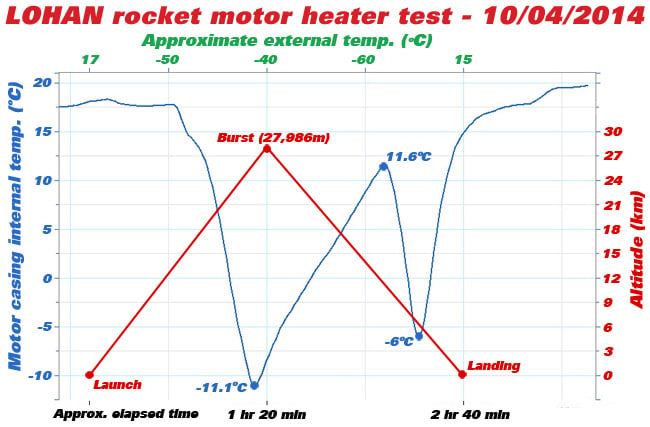This article is more than 1 year old
Vulture 2 rocket motor heater a non-sizzling success
LOHAN keeps things safely toasty at 28,000m
The Low Orbit Helium Assisted Navigator (LOHAN) team is toasting a toasty success today after reviewing the data from our recent Judy test flight, which carried the rocket motor heater rig designed to stop our Vulture 2 spaceplane's mighty thruster from catching a nasty cold.
Here's the data in question, captured as Judy rose to a heady 27,986m:
We'll come back to this lovingly hand-crafted graphic in a minute, but first up let's have a recap on the epic motor toaster saga. Our concern was that as our aircraft rose majestically heavenwards under the fantastical flying truss launch structure, its unprotected Cesaroni 54mm 3-grain motor would catch its death.
Ammonium perchlorate composite propellant (APCP), although it's guaranteed down to -5°C, doesn't much like the cold, and will not fire if it freezes, as low-temperature tests in our Rocketry Experimental High Altitude Barosimulator (REHAB) hypobaric chamber proved.
To launch a pre-emptive strike on the problem, we laid our hands on a space-grade Polyimide Thermofoil flexible heater:

The heater's effective area is 300.257 cm2, and its resistance is 64Ω. At 12V it draws 0.1875A and pumps out 2.24W, which translates to a watt density of 0.0078W/cm2. Not much, but ground tests showed that when hooked up to a 1300mAh Lithium Polymer (LiPo) battery (11.1V nominal), and insulated with space blanket and some whopping heatshrink, it was capable of maintaining the internal case temperature at around 5°C above ambient.
Here's the heater wrapped round the motor...
...and here's the complete set-up, complete with a 12V aquarium thermostat:

The thermostat was acquired to address another potential problem: that in the absence of air at altitude, the heater might actually melt down. Accordingly, we needed something to cut the power down if things got a little too hot for comfort.
In the end, it was a case of suck it and see, and here's the motor mounted atop the Judy payload:
The LiPo sat inside the styrofoam box with this bit of kit, a temperature logger with external probe.

While the heater temperature is monitored by a 10kΩ thermistor taped straight to the thermofoil and connected to the thermostat, we taped the logger probe inside the motor case and packed the whole thing tightly with (fireproof) nylon wadding, to simulate the presence of the motor APCP reload.
For the test flight, the thermostat was set to cut the juice at 50°C, as indicated by the thermistor, and reconnect when the temperature fell by 2°C.
Taking a shufti at the graph above, one thing is immediately apparent: that there's evidently a disparity between the temperature recorded by the thermistor and that inside the case.
The first dip in temperature, down to 11.1°C, presumably started when the thermistor recorded 50°C, and the thermostat cut the power. When the heater kicked back in at this lowest point, the internal temperature rose to a truly spectacular 11.6°C, at a time when the external ambient temperature was between -50 to -60°C.
This confirms our suspicion that with nowhere for the heat to go, the toaster without thermostatic supervision will just pump up the volume until it melts down.
Regarding that first dip in temperature, we've concluded that it's probably worth turning the thermostat cut-off temperature up to 70°C - 80°C, which we'd hope would keep the internal case temperature well above -5°C.
That aside, this is a good result, and now that we've shown all our efforts were not in vain, we can turn our attention back to the thorny issue of how to couple the Vulture 2 to the thermostat/battery pack.
LOHAN regulars will recall we've still haven't cracked this one, despite plenty of reader input. Since the moment has now arrived for a hot coupling, your final suggestions are welcome. ®
More from the lovely LOHAN:
- You can find full LOHAN coverage right here.
- If you're new to LOHAN, seek out our mission summary for enlightenment.
- There are photos our our magnificent Vulture 2 spaceplane here, and detailed structural plans here.
- For your further viewing pleasure, we have all our photographic material stored on Flickr.
- Our LOHAN and Paper Aircraft Released Into Space (PARIS) videos live on YouTube.
- We sometimes indulge in light consensual tweeting, as you can see here.














